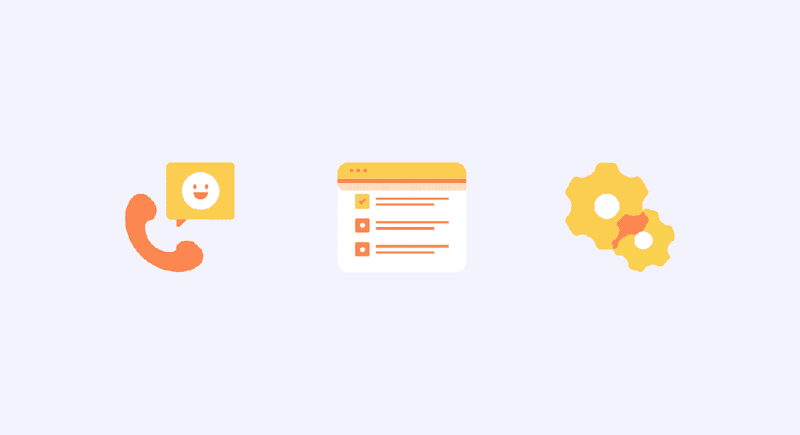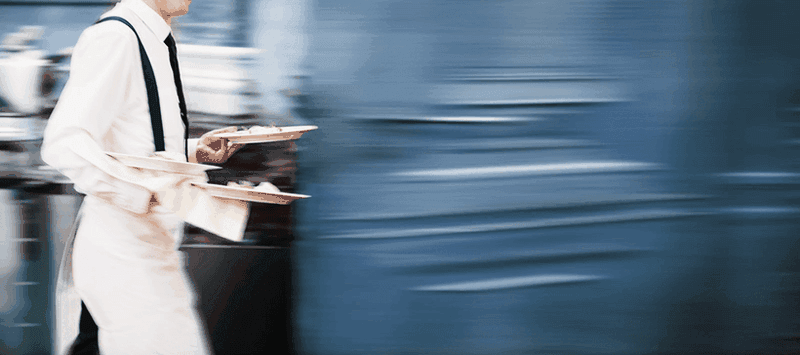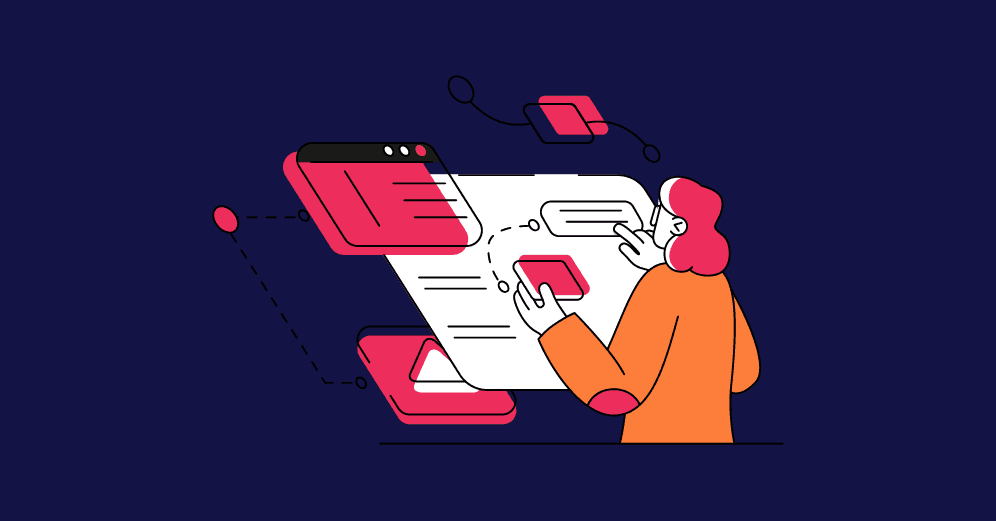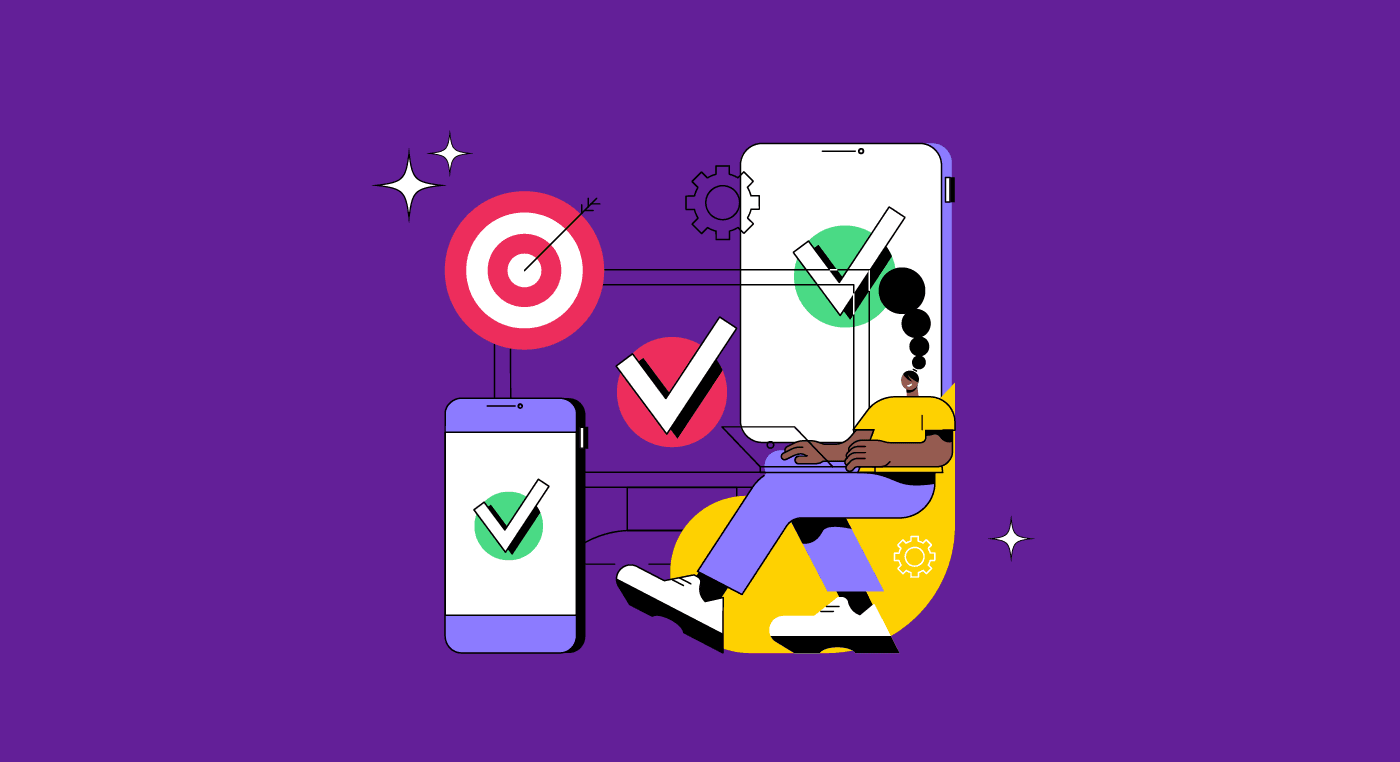You are excited about a new project you are working on and want to go somewhere different to hopefully get more ideas on the topic.
A famous coffee shop comes to mind. There the wi-fi is good, the tables are always clean and available, and to top it off it would be nice to have that coffee you like so much.
When you get to the store, you get in line, which is located in front of the salty snacks display case. You get in the mood and convince yourself that you are hungry. That was good because when it's time to order you don't have to think too much.
The attendant is friendly and responsive, takes your order, and asks for your name to let you know when your order is ready.
The coffee and the sandwich are ready quickly, you pick them up at the counter, choose a table, turn on the wi-fi, and get to work.
At the first sip of the coffee, you think, "the coffee may not be the best, but the service here is really very good. I think I'll come back tomorrow."
What can we observe in this simple everyday situation?
The interaction of a user with a brand goes far beyond the final product, in this case, the coffee. There are several important touch points that influence the final experience of your customer.
In this sense, thinking about these processes is as important as the final product.
This approach is called Service Design! In this article, we will explain a little more about this concept and how important it is in the development of your brand and your user experience!
What is Service?

There is a traditional line of thought, which clearly defines the differences between a good (product) and a service.
Following this line of thought, a product is something tangible and consumable – a car, a notebook, or a cell phone – while a service is something intangible and that does not characterize ownership by the recipient – medical care or public transportation.
However, the line between products and services is becoming increasingly thinner, and the two concepts often end up getting mixed up.
For example, music. In the past, to consume music you had to buy a record – tangible – and play it. Nowadays, you have a digital product – .mp3 – that can be listened to on streaming services, such as Spotify.
Notice that for the end user, there are small differences between consuming the music on a record or on a streaming service – as far as their need to basically listen to music is concerned. But for those behind the service, there is a huge difference between these two worlds.
So as the services evolve, so do the need to improve the user experience. In addition, the need for efficient user support increases.
To this end, well-defined processes must be in place within the company that provides the services. After all, a poorly designed process internally can greatly affect the user experience.
Therefore, to better understand the topic, it's important to understand the concept of Service Design.
Reading Tip: Design System: How To Create One?
What is Service Design?
Service Design is an approach in which it is possible to build an adequate process to improve the service to users and end customers.
The purpose of Service Design is to provide a quality experience to users, beyond the final product or service.
The points of contact of the user with a brand or company are not limited to the physical product. There are processes that precede and follow the purchase of a product. Attraction marketing and the post-sale process are some examples.
The goal of Service Design is to optimize and improve these processes so that the user feels satisfied as a whole, from end to end, and not only when using an interface or a final product.
As a consequence, besides improving the user experience, Service Design also ends up improving the experiences of the company's employees.
In this way, the concept of Service Design comes to improve the planning and organization of a company's resources – objects, people, and processes – to:
- improve the employee experience;
- improve the user experience.
So Service Design is about improving the organization's internal processes, believing that they also influence the end-user experience.
What is the difference between UX Design and Service Design?
Service Design has a broader scope and focus than UX Design.
While UX is exclusively focused on the user experience of an end product – application, website, other interfaces, or non-digital products – Service Design is focused on the end-to-end experience of the user and all people involved in a service.
In this respect, UX Design and Service Design complement each other.
UX focuses on who will use the product, and Service Design also focuses on who makes it.
The two concepts are interconnected because if the organization's internal processes are not flowing well, the end-user experience can be affected.
Therefore, it's important to care about both concepts, both UX Design and Service Design. Bringing the two together results in a good experience for both parties: those who make and those who consume.
Practical Example of Service Design
Let's take an example that is quite common in our lives: going to a restaurant.

The end product is the meal itself, but until the plate arrives on the table there are a number of processes and people involved in a visit to your favorite restaurant:
- booking a table by phone or app;
- waiting in line at the restaurant
- getting to the table, and initial service;
- you let the waiter know your order;
- the waiter takes the order and enters it into the system;
- the kitchen receives the order and starts coordinating and making your dish;
- meanwhile, the waiter brings the drinks;
- the kitchen finishes the order, having finished all the dishes at the same time;
- the waiter takes the dishes and hands them over to your table.
Notice that there are several touchpoints that influence the user/customer experience of the restaurant.
In the example above, maybe the UX Designer would only be bothered in developing an efficient application that allows booking tables in the restaurant.
But the user experience does not end there. The way the customer is greeted in the queue, how they are taken to the table and the attentiveness and kindness of the waiter are also important. In addition, the speed with which the meal arrives and, of course, whether the order comes correctly, are also crucial.
Therefore, even if the table reservation app is a success, the user experience does not end there and it also depends on the other processes within the restaurant.
A restaurant that does not have Service Design concepts in place will certainly not serve its customers in a successful way. The service in the queue will be inefficient, the dishes may arrive cold, wrong, or even take a long time to arrive at the table.
Thus, Service Design proves to be important because the whole process needs to provide the customer/user with an amazing experience during the whole service and contact with the restaurant, brand, or company.
Elements of Service Design
Just like in UX, Service Design has certain components that need to be designed and integrated correctly. Otherwise, the processes will not be efficient.
The components of Service Design are people, objects, and processes.

People
In Service Design, people are all those who are part of or use the service, as well as individuals who are indirectly affected by it.
As an example, we can mention:
- Employees;
- Customers;
- Partners.
Reading Tip: Why Are Balanced Teams So Important To UX?
Objects
This element of Service Design refers to any material – physical or digital – that is essential to the execution of the service.
Some examples are:
- Physical space (office);
- Digital Space (websites, applications, intranet);
- Files and documents;
- Any other physical or digital material.
Processes
The processes refer to the flowcharts and procedures performed by employees or by the end user, in order to carry out the service.
If we take the restaurant example above, some processes would be
- washing the dishes;
- receiving ingredients and purchasing materials;
- preparing each dish;
- entering the orders into the system.
How does the Service Design process work?
Besides knowing the elements of Service Design, it's interesting to understand how its development process works.
In this regard, we can list 5 major stages:
- Exploration;
- Creation;
- Reflection;
- Implementation;
- Identification of opportunities.
Exploration
The exploration stage involves understanding the brand, the company, the product, and the service, and trying to identify the problems and needs that must be solved to improve the experience of the people involved.
It is a stage of research and problem definition, but also of understanding the personas and the organization's own employees and stakeholders.
Creation
After the exploration, research, and problem definition, it is time to create the processes to solve the identified need.
In this phase, it's important to generate ideas and remodel them until an ideal model for implementation is reached.
During the creation phase it's important to remember that, even when designing a process, it's essential to always take into account the user experience at each stage.
Picture a process designed with post-its, where each colored piece of paper represents a part of the process. Between the papers, there will always be an arrow indicating the flow from one step to another. It is precisely in this flow that we need to pay attention to the user experience because this is where we need to provide feedback so that the user is aware that the process is flowing.
Reflection
In this stage, the development of the process happens through prototypes and tests.
In addition, it's important to have the participation of everyone involved in the process to ensure that the development contemplates all the nuances and does not miss any crucial detail for its implementation.
Reading Tip: Gestalt Principles: How To Apply Them In Your UX/UI Design Projects
Implementation
In this stage, the practical execution of the process solution created in the other stages takes place.
Here it's important to remember that we must take into account the necessary changes in the management and visualization of the work, the people involved in the service, and the process.
In many cases, the implementation of a new process does not necessarily require new tools or interfaces, but a change in mentality and empathy with the users.
Identifying opportunities
As with any process based on Design Thinking and Lean UX, it's important to never stop evaluating improvements in what has already been implemented.
In this sense, it's important to always collect feedback from users and employees themselves, in order to remedy risks and provide evolution to the implemented process.
Benefits of Service Design
As we have seen, Service Design aims to improve the organization's internal processes in order to enhance the employee experience, and consequently the user experience.
Neglect in internal processes often happens because the organization's resources are not fully user-centered.
Thus, Service Design helps to fix certain gaps in the organization by:
- Bringing conflicts into the discussion: in many cases, the company's business model is not aligned with the service it offers. This way, implementing Service Design brings to discussion the need for alignment between the models, in order to guarantee a good service level throughout the chain;
- Promoting collaborative discussions: by exposing the processes and their weak links, Service Design proposes the discussion of these flows to find solutions in a collaborative and cross-functional way;
- Reducing rework: by promoting the mapping of all processes and procedures, Service Design enables the identification of which activities are redundant, thus saving resources and energy;
- Building relationships: by prioritizing the alignment of activities, Service Design promotes improved relationships among employees and among the company's areas. The idea is to align all the information related to the service that impacts the user experience.
In addition, Service Design helps increase the competitiveness of the brand/company and provides the user and employees with an experience closer to its culture and values.
Reading Tip: Product Manager: Business, Technology, and User Experience
The 5 principles of Service Design Thinking
To implement the concept of Service Design you also need to understand the design thinking process behind it.
Thus, Marc Stickdorn, in his book "This Is Service Design Thinking", conceptualizes the 5 fundamental principles of Service Design:
- User-Centered;
- Co-creative;
- Sequencing;
- Evidencing;
- Holistic.

User-Centered
It is important to emphasize that, in this principle, when we talk about the user, we are not necessarily talking about the end user of the product or service. Remember that Service Design is related to the internal processes of organizations.
Therefore, to think about the user is to think about the collaborator and all the players that exist within an organization and that are impacted by the service.
The concept of user-centered design is not something different from what we are used to writing about here.
Putting the user at the center of the development is also fundamental in Service Design. Mainly because services do not exist without people and, unlike physical products, they cannot be stored on shelves and wait for their consumption.
So putting the user at the center of the service development process is crucial.
Moreover, Marc Stickdorn further emphasizes the importance of getting to know the person who will use the services very well.
It is necessary to understand the user's reality, what their experiences are or have been, and the context in which they are inserted.
Putting the user at the center of Service Design is to know how to use all the deep knowledge we have about them to develop a successful service.
Reading Tip: How To Create Valuable User Personas That Will Actually Matter?
Co-creative
Putting the user at the center of the Service Design process allows you to realize that there are several groups of customers and stakeholders that are impacted by the proposed service.
In this way, co-creation means allowing the participation of all these agents in the development of the service of which they themselves will be a part. And this includes all employees of the areas and the stakeholders inherent to the processes and services.
In this regard, the Service Designer is responsible for creating a favorable environment for creativity, problem-solving, and understanding the users' needs.
Allowing the participation of users is a fundamental part of the development of an efficient service.
Sequencing
Marck Stickdorn makes an analogy between the processes involved in a service, a movie, or a play.
In a movie, the scenes and sequences have a set time, giving rhythm to the process as a whole. There are moments in which the idea is to make the viewer more anxious, in others more relaxed, and so on. Everything is based on creating the expectation of those who are watching.
Following the same logic, services need their processes to have timing that does not harm the user experience.
To do so, it is necessary to break the service processes into touchpoints, which represent a moment of user interaction. Combined, the touchpoints create a service moment.
The sequence of these service moments must be well coordinated and thought out in order to create the necessary expectations in the user, establishing efficient communication and giving rhythm to the user's journey without creating unpleasant sensations.
Continuing with our restaurant example, suppose you are having dinner with your friends and your order arrives first and the others wait more than 30 minutes for the dish to arrive. This lack of synchronization in timing will generate frustration for everyone. For you, because if you wait for the orders of your friends to arrive, your dish will already be cold when you eat it. And also for the others, because they will watch you eat and will not be able to enjoy this moment together.
Evidencing
Many services go unnoticed by the users. In fact, it may be that the invisibility of a service is precisely the reason for its success. Example: You receive your bags on the conveyor belt after a flight. You usually only notice this service if something goes wrong.
But if a service is not noticed, how will the end user remember or recommend it?
Evidence, then, is the principle of Service Design that seeks to make the user remember, preferably with satisfaction, what the experience with that service was like.
Think about vacations, for example. It is quite common to bring back small souvenirs from the cities we visited. Most of these souvenirs are not very attractive, aesthetically speaking. But they bring back that moment of happiness when we were on vacation, getting to know a new place.
In this way, and going in the same direction, the services have to remain in the user's memory so that they return or recommend them.
The evidence can be of various forms: email, letters, small gifts, products, etc.
But be careful, bringing this tangibility and evidence to the service can cause discomfort for the user. Think of spam emails, for example. So you need to use evidence with caution so that it is, in fact, effective.
Holistic
Finally, the last principle of Service Design is to be Holistic.
The service, as we have seen so far, is composed of processes, objects, and people. And, within a company, there are several services, composed of several people and processes.
As such, it is important that all these services and processes are within the same context and with the same objective within the organization, giving rise to a single large system.
This system will only be efficient if each of the services is aligned with its culture, values, and rules.
Reading Tip: Benchmarking: How To Conduct One?
Service Blueprint: the essential Service Design tool
As seen, Service Design consists in improving service processes.
Therefore, a tool that can map these processes is needed so that the analysis can be done.
The essential tool for this is the Service Blueprint.
What is the Service Blueprint?

The Service Blueprint is a diagram that shows the relationships between all elements of Service Design – processes, people, and objects – that are part of the customer journey within a service.
In other words, the Blueprint works as a service map, where we can identify improvements and opportunities, and shows which are the elements of the service, the time, and its flow.
We have written an exclusive article about this tool and you can access it right below:
Service Blueprint: A Service Design Tool
With this article, we hope to clarify the importance of establishing Service Design within your company, improving the experience of both your employees and the end user!
If you are interested and want to learn more about Service Design, check out the various materials available on the Nielsen Norman Group (NN/g) website.








